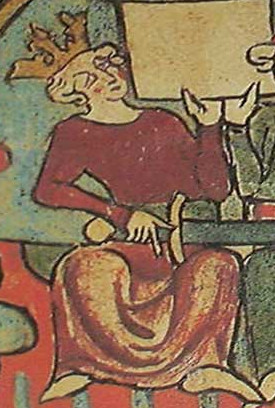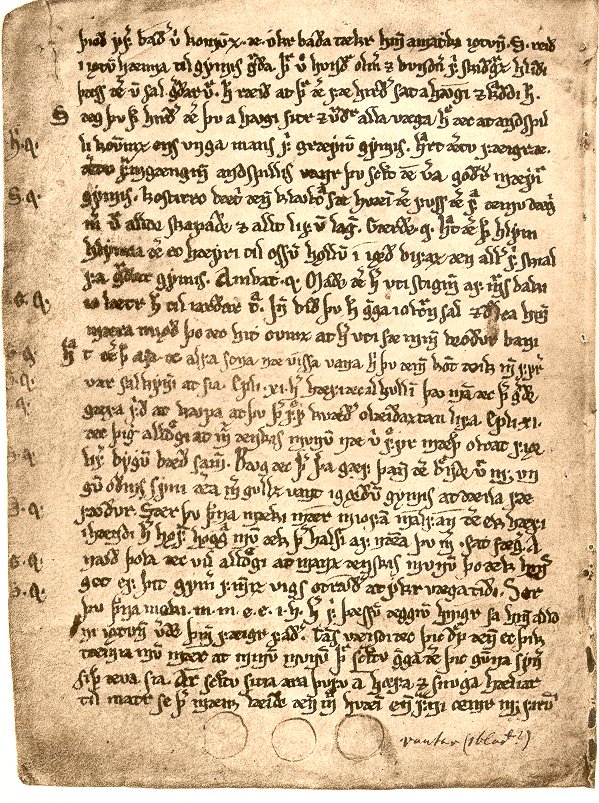|
Bærings Saga
''Bærings saga'' or ''Bærings saga fagra'' is a medieval Icelandic romance saga. Its oldest manuscript is from the early fourteenth-century, allowing the saga to be dated relatively securely to the beginning of the period of Icelandic production of romances. Synopsis Kalinke and Mitchell summarise the saga thus: The saga recounts Bæring's efforts to avenge the death of his uncle, ruler of Ertinborg, who had been killed by one of his own knights, Heinrekr. Heinrekr proposes marriage to Bæring's widowed mother, sister of the murdered ruler. Rejected, he vows to kill Bæringr. Mother and child flee to England, where Bæringr eventually is knighted. He travels to the continent and serves under the rulers of Frakkland, Grikkland, and Romaborg, distinguishing himself in tournament and war. Several princesses fall passfonately in love with him, but he rejects them. Eventually, he vanquishes Heinrekr, becomes ruler of his patrimonial as well as other lands, and marries the daughter of ... [...More Info...] [...Related Items...] OR: [Wikipedia] [Google] [Baidu] |
Romance Saga
The ''riddarasögur'' (literally 'sagas of knights', also known in English as 'chivalric sagas', 'romance-sagas', 'knights' sagas', 'sagas of chivalry') are Norse prose sagas of the romance genre. Starting in the thirteenth century with Norse translations of French '' chansons de geste'' and Latin romances and histories, the genre expanded in Iceland to indigenous creations in a similar style. While the ''riddarasögur'' were widely read in Iceland for many centuries they have traditionally been regarded as popular literature inferior in artistic quality to the Icelanders' sagas and other indigenous genres. Receiving little attention from scholars of Old Norse literature, many remain untranslated. The production of chivalric sagas in Scandinavia was focused on Norway in the thirteenth century and then Iceland in the fourteenth. Vernacular Danish and Swedish romances came to prominence rather later and were generally in verse; the most famous of these are the Eufemiavisorna, the ... [...More Info...] [...Related Items...] OR: [Wikipedia] [Google] [Baidu] |
Rémundar Saga Keisarasonar
''Rémundar saga keisarasonar'' is a medieval Icelandic romance saga The ''riddarasögur'' (literally 'sagas of knights', also known in English as 'chivalric sagas', 'romance-sagas', 'knights' sagas', 'sagas of chivalry') are Norse prose sagas of the romance genre. Starting in the thirteenth century with Norse tr ..., and the longest of those romance-sagas composed in medieval Iceland.Robert Cook, 'Rémundar saga keisarasonar', in ''Medieval Scandinavia: An Encyclopedia'', ed. by Phillip Pulsiano (New York: Garland, 1993), p. 526. Synopsis Kalinke and Mitchell summarise the saga thus: Rémundr falls in love with a maiden whom he has seen only in his dreams. Carrying a statue of the maiden he sets off in search of her. Rémundr kills Eskupart who claimed to be the maiden's lover, but is himself wounded. Before he died Eskupart prophesied that Rémundr could be healed only by the most beautiful woman in the world. After many adventures, Rémundr is healed in India by Elina, the ... [...More Info...] [...Related Items...] OR: [Wikipedia] [Google] [Baidu] |
Þiðreks Saga
''Þiðreks saga af Bern'' ('the saga of Þiðrekr of Bern', also ''Þiðrekssaga'', ''Þiðriks saga'', ''Niflunga saga'' or ''Vilkina saga'', with Anglicisations including ''Thidreksaga'') is an Old Norse chivalric saga centering the character it calls Þiðrekr af Bern, who originated as the historical king Theoderic the Great (454–526), but who attracted a great many unhistorical Germanic heroic legends. The text is probably by a Norwegian scholar from the 1200s who translated a lost Low German prose narrative of Theoderic's life, or who compiled it from various German sources, or by an Icelandic scholar from the 1300s. It is a pre-eminent source for a wide range of medieval Germanic legends. Titles The name ''Vilkinasaga'' was first used in Johan Peringskiöld's Swedish translation of 1715. Peringskiöld named it after ''Vilkinaland'', which the saga says was an old name for Sweden and Götaland. Origins The saga contains many narratives found in other medieval tales ab ... [...More Info...] [...Related Items...] OR: [Wikipedia] [Google] [Baidu] |
Ívens Saga
, original_title_lang = fro , translator = , written = between 1178 and 1181 , country = , language = Old French , subject = Arthurian legend , genre = Chivalric romance , form = , meter = Octosyllable , rhyme = Rhyming couplets , lines = 6,818 , oclc = , wikisource = Yvain, the Knight of the Lion , orig_lang_code = fr , native_wikisource = Yvain ou le Chevalier au Lion ''Yvain, the Knight of the Lion'' (french: Yvain ou le Chevalier au Lion) is an Arthurian romance by French poet Chrétien de Troyes. It was written c. 1180 simultaneously with '' Lancelot, the Knight of the Cart'', and includes several references to the narrative of that poem. It is a story of knight-errantry, in which the protagonist Yvain is first rejected by his lady for breaking a very important promise, and subsequently performs a number of heroi ... [...More Info...] [...Related Items...] OR: [Wikipedia] [Google] [Baidu] |
Rímur
In Icelandic literature, a ''ríma'' (, literally "a rhyme", pl. ''rímur'', ) is an epic poem written in any of the so-called ''rímnahættir'' (, "rímur meters"). They are rhymed, they alliterate and consist of two to four lines per stanza. The plural, ''rímur'', is either used as an ordinary plural, denoting any two or more rímur, but is also used for more expansive works, containing more than one ríma as a whole. Thus '' Ólafs ríma Haraldssonar'' denotes an epic about Ólafr Haraldsson in one ríma, while '' Núma rímur'' are a multi-part epic on Numa Pompilius. Form ''Rímur'', as the name suggests, rhyme, but like older Germanic alliterative verse, they also contain structural alliteration. ''Rímur'' are stanzaic, and stanzas normally have four lines. There are hundreds of ''ríma'' meters: Sveinbjörn Beinteinsson counts 450 variations in his ''Háttatal''. But they can be grouped in approximately ten ''families''. The most common metre is ''ferskeytt''.Véstein ... [...More Info...] [...Related Items...] OR: [Wikipedia] [Google] [Baidu] |
Faroese Ballad
Faroese ( ) or Faroish ( ) may refer to anything pertaining to the Faroe Islands, e.g.: *the Faroese language Faroese ( ; ''føroyskt mál'' ) is a North Germanic language spoken as a first language by about 72,000 Faroe Islanders, around 53,000 of whom reside on the Faroe Islands and 23,000 in other areas, mainly Denmark. It is one of five languages de ... * the Faroese people {{Disambiguation Language and nationality disambiguation pages ... [...More Info...] [...Related Items...] OR: [Wikipedia] [Google] [Baidu] |
Chivalric Sagas
The ''riddarasögur'' (literally 'sagas of knights', also known in English as 'chivalric sagas', 'romance-sagas', 'knights' sagas', 'sagas of chivalry') are Norse prose sagas of the romance genre. Starting in the thirteenth century with Norse translations of French '' chansons de geste'' and Latin romances and histories, the genre expanded in Iceland to indigenous creations in a similar style. While the ''riddarasögur'' were widely read in Iceland for many centuries they have traditionally been regarded as popular literature inferior in artistic quality to the Icelanders' sagas and other indigenous genres. Receiving little attention from scholars of Old Norse literature, many remain untranslated. The production of chivalric sagas in Scandinavia was focused on Norway in the thirteenth century and then Iceland in the fourteenth. Vernacular Danish and Swedish romances came to prominence rather later and were generally in verse; the most famous of these are the Eufemiavisorna, them ... [...More Info...] [...Related Items...] OR: [Wikipedia] [Google] [Baidu] |
Icelandic Literature
Icelandic literature refers to literature written in Iceland or by Icelandic people. It is best known for the sagas written in medieval times, starting in the 13th century. As Icelandic and Old Norse are almost the same, and because Icelandic works constitute most of Old Norse literature, Old Norse literature is often wrongly considered a subset of Icelandic literature. However, works by Norwegians are present in the standard reader ''Sýnisbók íslenzkra bókmennta til miðrar átjándu aldar'', compiled by Sigurður Nordal on the grounds that the language was the same. Early Icelandic literature The medieval Icelandic literature is usually divided into three parts: *Eddic poetry *Sagas *Skaldic poetry The ''Eddas'' There has been some discussion on the probable etymology of the term "Edda". Most say it stems from the Old Norse term ''edda'', which means great-grandmother, but some see a reference to Oddi, a place where Snorri Sturluson Snorri Sturluson ( ; ; 1179 – 22 S ... [...More Info...] [...Related Items...] OR: [Wikipedia] [Google] [Baidu] |


_Owain.jpg)
